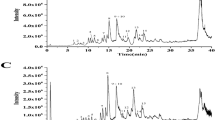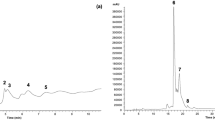Abstract
Purpose
The recognized biological properties of Ginkgo biloba extracts potentiate their utilization as an ingredient for functional foods. However, the digestive conditions can affect the chemical composition of the extracts and consequently their biological properties, which can lead to food safety problems. Thus, the impact of in vitro-simulated upper gastrointestinal tract digestion on the chemical composition and bioactivity of Ginkgo biloba leaf extract (GBE) was evaluated.
Methods
Physicochemical conditions of human digestion were simulated in vitro, and its impact on the chemical composition of GBE was investigated by electrospray ionization-mass spectrometry. The persistence of bioactivity was investigated by subjecting GBE and the in vitro digested extract (DGBE) to the same methodology. Antioxidant properties were assessed using 2′,7′-dichlorofluorescein diacetate to measure the intracellular oxidation of Schizosaccharomyces pombe cells pre-incubated with GBE or DGBE and exposed to H2O2. Antigenotoxicity was tested by comet assay in HT-29 colon cancer cells pre-incubated with GBE or DGBE and challenged with H2O2.
Results
The chemical analysis revealed a considerable change in chemical composition upon digestion. Pre-incubation with GBE or DGBE attenuated the H2O2-imposed intracellular oxidation in wild-type S. pombe cells, unlike the oxidative stress response-affected mutants sty1 and pap1, and decreased H2O2-induced DNA damage in HT-29 cells. The extracts did not induce toxicity in these eukaryotic models.
Conclusion
The chemical composition of GBE was affected by in vitro digestion, but the antioxidant and antigenotoxic activities persisted. Therefore, G. biloba extract may be suitable for use as food additive and contribute to a healthy colon.




Similar content being viewed by others
Abbreviations
- DGBE:
-
In vitro digested Ginkgo biloba leaf extract
- GAE:
-
Gallic acid equivalents
- GBE:
-
Ginkgo biloba leaf extract
- H2DCFDA:
-
2′,7′-Dichlorofluorescein diacetate
- MS:
-
Mass spectrometry
- MTT:
-
3-(4,5-Dimethylthiazol-2-yl)-2,5-diphenyltetrazolium bromide
- Na2EDTA:
-
Ethylenediaminetetraacetic acid, disodium salt
- PBS:
-
Phosphate-buffered saline
- PI:
-
Propidium iodide
- ROS:
-
Reactive oxygen species
- TPC:
-
Total phenolic content
- TRIS:
-
2-Amino-2-(hydroxymethyl)propane-1,3-diol
References
Dolatabadi JEN, Kashanian S (2010) A review on DNA interaction with synthetic phenolic food additives. Food Res Int 43(5):1223–1230. https://doi.org/10.1016/j.foodres.2010.03.026
Lugasi A, Dworschak E, Horvatovich P (1999) Additional information to the in vitro antioxidant activity of Ginkgo biloba L. Phytother Res 13(2):160–162
Boghdady NAE (2013) Antioxidant and antiapoptotic effects of proanthocyanidin and Ginkgo biloba extract against doxorubicin-induced cardiac injury in rats. Cell Biochem Funct 31(4):344–351. https://doi.org/10.1002/cbf.2907
Mahadevan S, Park Y (2008) Multifaceted therapeutic benefits of Ginkgo biloba L. chemistry, efficacy, safety, and uses. J Food Sci 73(1):R14–R19. https://doi.org/10.1111/j.1750-3841.2007.00597.x
He J, Lin J, Li J, Zhang JH, Sun XM, Zeng CM (2009) Dual effects of Ginkgo biloba leaf extract on human red blood cells. Basic Clin Pharmacol Toxicol 104(2):138–144. https://doi.org/10.1111/j.1742-7843.2008.00354.x
Ude C, Schubert-Zsilavecz M, Wurglics M (2013) Ginkgo biloba extracts: a review of the pharmacokinetics of the active ingredients. Clin Pharmacokinet 52(9):727–749. https://doi.org/10.1007/s40262-013-0074-5
Smith JV, Luo Y (2004) Studies on molecular mechanisms of Ginkgo biloba extract. Appl Microbiol Biotechnol 64(4):465–472. https://doi.org/10.1007/s00253-003-1527-9
Marques F, Azevedo F, Johansson B, Oliveira R (2011) Stimulation of DNA repair in Saccharomyces cerevisiae by Ginkgo biloba leaf extract. Food Chem Toxicol 49(6):1361–1366. https://doi.org/10.1016/j.fct.2011.03.020
Vilar JB, Leite KR, Chen Chen L (2009) Antimutagenicity protection of Ginkgo biloba extract (Egb 761) against mitomycin C and cyclophosphamide in mouse bone marrow. Genet Mol Res 8(1):328–333
Gohil K, Moy RK, Farzin S, Maguire JJ, Packer L (2000) mRNA expression profile of a human cancer cell line in response to Ginkgo biloba extract: induction of antioxidant response and the golgi system. Free Radic Res 33(6):831–849. https://doi.org/10.1080/10715760000301351
Jeyakumar A, Dissabandara L, Gopalan V (2017) A critical overview on the biological and molecular features of red and processed meat in colorectal carcinogenesis. J Gastroenterol 52(4):407–418. https://doi.org/10.1007/s00535-016-1294-x
Coates EM, Popa G, Gill CI, McCann MJ, McDougall GJ, Stewart D, Rowland I (2007) Colon-available raspberry polyphenols exhibit anti-cancer effects on in vitro models of colon cancer. J Carcinog 6:4. https://doi.org/10.1186/1477-3163-6-4
Demeyer D, Mertens B, De Smet S, Ulens M (2016) Mechanisms linking colorectal cancer to the consumption of (processed) red meat: a review. Crit Rev Food Sci Nutr 56(16):2747–2766. https://doi.org/10.1080/10408398.2013.873886
Araújo JR, Goncalves P, Martel F (2011) Chemopreventive effect of dietary polyphenols in colorectal cancer cell lines. Nutr Res 31(2):77–87. https://doi.org/10.1016/j.nutres.2011.01.006
Singleton VL, Orthofer R, Lamuela-Raventós RM (1999) Analysis of total phenols and other oxidation substrates and antioxidants by means of Folin-Ciocalteu reagent. In: Methods in enzymology, vol 299. Academic Press, New York, pp 152–178. https://doi.org/10.1016/S0076-6879(99)99017-1
Vivancos AP, Jara M, Zuin A, Sanso M, Hidalgo E (2006) Oxidative stress in Schizosaccharomyces pombe: different H2O2 levels, different response pathways. Mol Genet Genom 276(6):495–502. https://doi.org/10.1007/s00438-006-0175-z
Mosmann T (1983) Rapid colorimetric assay for cellular growth and survival: application to proliferation and cytotoxicity assays. J Immunol Methods 65(1–2):55–63. https://doi.org/10.1016/0022-1759(83)90303-4
Brown EM, Latimer C, Allsopp P, Ternan NG, McMullan G, McDougall GJ, Stewart D, Crozier A, Rowland I, Gill CI (2014) In vitro and in vivo models of colorectal cancer: antigenotoxic activity of berries. J Agric Food Chem 62(18):3852–3866. https://doi.org/10.1021/jf4050759
Collins AR (2004) The comet assay for DNA damage and repair. Mol Biotechnol 26(3):249. https://doi.org/10.1385/mb:26:3:249
Lee H, Lim H, Yang J, Hong J (2013) Rapid determination of ginkgolic acids in Ginkgo biloba leaf using online column switching high-performance liquid chromatography-diode array detection and confirmation by liquid chromatography-tandem mass spectrometry. Bull Korean Chem Soc 34(12):3629–3634. https://doi.org/10.5012/bkcs.2013.34.12.3629
Lin LZ, Chen P, Ozcan M, Harnly JM (2008) Chromatographic profiles and identification of new phenolic components of Ginkgo biloba leaves and selected products. J Agric Food Chem 56(15):6671–6679. https://doi.org/10.1021/jf800488x
He X-g, Bernart MW, Nolan GS, Lin L-z, Lindenmaier MP (2000) High-performance liquid chromatography—electrospray ionization-mass spectrometry study of ginkgolic acid in the leaves and fruits of the ginkgo tree (Ginkgo biloba). J Chromatogr Sci 38(4):169–173. https://doi.org/10.1093/chromsci/38.4.169
Pereira E, Barros L, Dueñas M, Antonio AL, Santos-Buelga C, Ferreira ICFR (2015) Gamma irradiation improves the extractability of phenolic compounds in Ginkgo biloba L. Ind Crops Prod 74:144–149. https://doi.org/10.1016/j.indcrop.2015.04.039
Marín L, Miguélez EM, Villar CJ, Lombó F (2015) Bioavailability of dietary polyphenols and gut microbiota metabolism: antimicrobial properties. BioMed Res Int 2015:18. https://doi.org/10.1155/2015/905215
Linoleic acid (2016) MassBank http://www.massbank.jp/jsp/Dispatcher.jsp?type=disp&id=MT000114&site=12. Accessed 4 Jan 2018
Karaś M, Jakubczyk A, Szymanowska U, Złotek U, Zielińska E (2017) Digestion and bioavailability of bioactive phytochemicals. Int J Food Sci Technol 52(2):291–305. https://doi.org/10.1111/ijfs.13323
McDougall GJ, Dobson P, Smith P, Blake A, Stewart D (2005) Assessing potential bioavailability of raspberry anthocyanins using an in vitro digestion system. J Agric Food Chem 53(15):5896–5904. https://doi.org/10.1021/jf050131p
Goh LML, Barlow PJ (2004) Flavonoid recovery and stability from Ginkgo biloba subjected to a simulated digestion process. Food Chem 86(2):195–202. https://doi.org/10.1016/j.foodchem.2003.08.035
Yokomizo A, Moriwaki M (2005) Myricitrin degraded by simulated digestion inhibits oxidation of human low-density lipoprotein. Biosci Biotechnol Biochem 69(4):693–699. https://doi.org/10.1271/bbb.69.693
Bermúdez-Soto MJ, Tomás-Barberán FA, García-Conesa MT (2007) Stability of polyphenols in chokeberry (Aronia melanocarpa) subjected to in vitro gastric and pancreatic digestion. Food Chem 102(3):865–874. https://doi.org/10.1016/j.foodchem.2006.06.025
Huang D, Ou B, Prior RL (2005) The chemistry behind antioxidant capacity assays. J Agric Food Chem 53(6):1841–1856. https://doi.org/10.1021/jf030723c
Yen G-C, Chen H-Y, Peng H-H (1997) Antioxidant and pro-oxidant effects of various tea extracts. J Agric Food Chem 45(1):30–34. https://doi.org/10.1021/jf9603994
Llópiz N, Puiggròs F, Céspedes E, Arola L, Ardévol A, Bladé C, Salvadó MJ (2004) Antigenotoxic effect of grape seed procyanidin extract in Fao cells submitted to oxidative stress. J Agric Food Chem 52(5):1083–1087. https://doi.org/10.1021/jf0350313
Jang I-C, Jo E-K, Bae M-S, Lee H-J, Jeon G-I, Park E, Yuk H-G, Ahn G-H, Lee S-C (2010) Antioxidant and antigenotoxic activities of different parts of persimmon (Diospyros kaki cv. Fuyu) fruit. J Med Plant Res 4(2):155–160
He Y-T, Xing S-S, Gao L, Wang J, Xing Q-C, Zhang W (2014) Ginkgo biloba attenuates oxidative DNA damage of human umbilical vein endothelial cells induced by intermittent high glucose. Pharmazie 69(3):203–207. https://doi.org/10.1691/ph.2014.3819
Križková L, Chovanová Z, Ďuračková Z, Krajčovič J (2008) Antimutagenic in vitro activity of plant polyphenols: Pycnogenol® and Ginkgo biloba extract (EGb 761). Phytother Res 22(3):384–388. https://doi.org/10.1002/ptr.2331
Kahle K, Kraus M, Scheppach W, Richling E (2005) Colonic availability of apple polyphenols—a study in ileostomy subjects. Mol Nutr Food Res 49(12):1143–1150. https://doi.org/10.1002/mnfr.200500132
Borges G, Lean ME, Roberts SA, Crozier A (2013) Bioavailability of dietary (poly) phenols: a study with ileostomists to discriminate between absorption in small and large intestine. Food Funct 4(5):754–762. https://doi.org/10.1039/C3FO60024F
Stalmach A, Edwards CA, Wightman JD, Crozier A (2012) Gastrointestinal stability and bioavailability of (poly)phenolic compounds following ingestion of Concord grape juice by humans. Mol Nutr Food Res 56(3):497–509. https://doi.org/10.1002/mnfr.201100566
Brown EM, McDougall GJ, Stewart D, Pereira-Caro G, Gonzalez-Barrio R, Allsopp P, Magee P, Crozier A, Rowland I, Gill CI (2012) Persistence of anticancer activity in berry extracts after simulated gastrointestinal digestion and colonic fermentation. PLoS One 7(11):e49740. https://doi.org/10.1371/journal.pone.0049740
Del Pino-García R, Rivero-Pérez MD, González-SanJosé ML, Ortega-Heras M, García Lomillo J, Muñiz P (2017) Chemopreventive potential of powdered red wine pomace seasonings against colorectal cancer in HT-29 Cells. J Agric Food Chem 65(1):66–73. https://doi.org/10.1021/acs.jafc.6b04561
El Mesallamy HO, Metwally NS, Soliman MS, Ahmed KA, Abdel Moaty MM (2011) The chemopreventive effect of Ginkgo biloba and Silybum marianum extracts on hepatocarcinogenesis in rats. Cancer Cell Int 11(1):38. https://doi.org/10.1186/1475-2867-11-38
Keles MS, Demirci N, Yildirim A, Atamanalp SS, Altinkaynak K (2008) Protective effects of N-acetylcysteine and Ginkgo biloba extract on ischaemia-reperfusion-induced hepatic DNA damage in rats. Clin Exp Med 8(4):193–198. https://doi.org/10.1007/s10238-008-0005-1
Abdel-Wahab BA, Abd El-Aziz SM (2012) Ginkgo biloba protects against intermittent hypoxia-induced memory deficits and hippocampal DNA damage in rats. Phytomedicine 19(5):444–450. https://doi.org/10.1016/j.phymed.2011.11.011
Fang L, Neutzner A, Turtschi S, Flammer J, Mozaffarieh M (2015) The effect of Ginkgo biloba and Nifedipine on DNA breaks in circulating leukocytes of glaucoma patients. Expert Rev Ophthalmol 10(3):313–318. https://doi.org/10.1586/17469899.2015.1043994
Acknowledgements
This work is supported by European Investment Funds by FEDER/COMPETE/POCI—Operational Competitiveness and Internationalization Programme, under Project POCI-01-0145-FEDER-006958 and National Funds by FCT—Portuguese Foundation for Science and Technology, under the project UID/AGR/04033/2019. This work has also been funded by national funds through FCT—Fundação para a Ciência e a Tecnologia for Centre of Chemistry (UID/QUI/00686/2013 and UID/QUI/0686/2016).
Author information
Authors and Affiliations
Corresponding author
Ethics declarations
Conflict of interest
The authors declare that they have no conflict of interests.
Ethical standards
The manuscript does not contain clinical studies or patient data.
Electronic supplementary material
Below is the link to the electronic supplementary material.
Rights and permissions
About this article
Cite this article
Oliveira, D., Latimer, C., Parpot, P. et al. Antioxidant and antigenotoxic activities of Ginkgo biloba L. leaf extract are retained after in vitro gastrointestinal digestive conditions. Eur J Nutr 59, 465–476 (2020). https://doi.org/10.1007/s00394-019-01915-8
Received:
Accepted:
Published:
Issue Date:
DOI: https://doi.org/10.1007/s00394-019-01915-8




